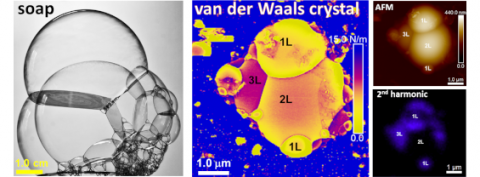Variant equilibrium laws in atomically thin crystals: Crystal bubbles behave differently

Soap bubbles are pretty, coloured, mobile, and fragile. Indeed, soap bubbles are a favourite game for children (and adults…). Nevertheless, these objects have been a model system for fundamental research in equilibrated states involving capillarity and wetting phenomena that have profound implications in living systems and industrial applications [1]. The way bubbles interact and intersect are ruled by the Plateau’s laws dating back to the 19th century [2]. In particular, Joseph Plateau’s fundamental observations of soap bubbles revealed that their borders meet at equal joint angles of 120°. This law has been a prominent physical law in natural sciences. Apart from soap bubbles, Plateau’s law naturally occurs in liquid foams such as beer froth, and in solid foams such as cells, honeycombs, and metallic foams. Whilst some studies have shown that the joint angles in bubbles and foams are not always 120°, the angle deviation is quite small of only a few degrees. Due to the low surface tension of liquids, such as 0.07–0.09 N/m for water and 0.025 N/m for soap bubbles, the capped pressure in liquid bubbles is low and they only exist for short periods of time before bursting. What should we expect when bubbles occur in solid state systems? The laboratory of Optical Spectroscopy of Nanostructured Materials (OPERA) (https://antoniopolimeni-physics.weebly.com/) showed that hydrogen-ion irradiation leads to the shape/size/site-controllable formation of crystal bubbles (or domes) in van der Waals crystals (such as transition metal dichalcogenides, TMDs, and hexagonal boron nitride, hBN) [3]. In these materials, layers of atoms with strong in-plane (covalent) bonds are stacked together via weak van der Waals (dipolar) bonds, akin graphene in graphite.
The OPERA group showed that accelerated protons penetrate through the crystal top plane of TMDs and hBN, then leading to the formation and coalescence of molecular hydrogen. The weak interlayer van der Waals bonds in these materials enable the blistering of nanometer/micrometer sized bubbles with atomic thickness (two-dimensional, 2D, limit) and filled with highly pressurized (several tens of atm) hydrogen gas. These 2D mono- and few-layer bubbles are at least two orders of magnitude thinner than soap bubble films, but much more robust, with interesting electronic/optical properties [4], strong mechanical strength, as well as unprecedented chemical and thermal stability [5]. Elena Blundo and Antonio Polimeni, in collaboration with colleagues at the Australian National University, the National Institute for Materials Science (Japan) and the Jilin University (China), successfully created atomically thin TMD bubble networks and observed variant Plateau’s law in such nano-scale solid systems.
The results are published in Nature Communications [6], where it is shown that the variant Plateau’s law is due to thickness dependent stiffness values depending on the bubble layer number, resulting in large effective surface tension differences, which leads to the formation of large joint angle differences of approximately 77° between the largest and smallest angles. This contrasts with the equal joint angles commonly associated with Plateau’s law, demonstrating that this variant is observed due to the 2D TMD bubble network properties. Furthermore, the equivalent surface tension of our TMD bubbles ranges from 2.4 to 3.6N/m, around two orders of magnitude greater than conventional liquid films, enabling the 2D bubbles to sustain high gas pressure and exist in a fundamentally variant nature for several years.
Bubble networks can become a promising topic for generating 1D or 2D nanostructures with large variation in properties enabling new device applications in the fields of nano-photonics, nano-opto-mechanics and quantum science.
[1] Pierre-Gilles De Gennes, Françoise Brochard-Wyart, and David Quéré, Capillarity and Wetting Phenomena: Drops, Bubbles, Pearls, Waves (Springer-Verlag, New York, 2004)
[2] J. A. Plateau, Statique expérimentale et théorique des liquids soumis aux seules forces moléculaires Vol. 2 (Gauthier-Villars,1873)
[3] E. Blundo et al., Nano Letters 22, 1525 (2022); D. Tedeschi, E. Blundo et al., Advanced Materials 31, 1970314 (2019)
[4] E. Blundo et al., Physical Review Letters 129, 067402 (2022)
[5] E. Blundo et al., Physical Review Letters 127, 046101 (2021); C. Di Giorgio et al., ACS Applied Materials & Interfaces 13, 48228 (2021)
[6] B. Liu et al., Nature Communications 14, 1050 (2023); https://doi.org/10.1038/s41467-023-36565-2
